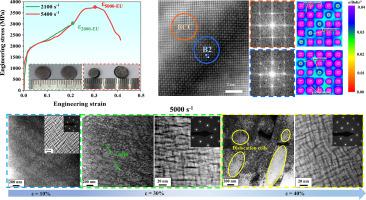通过B2有序和旋量分解增强难熔高熵合金在动载荷下的应变硬化和强度塑性协同作用
IF 12.8
1区 材料科学
Q1 ENGINEERING, MECHANICAL
引用次数: 0
摘要
耐火高熵合金(RHEAs)在高应变率应用中具有重要的前景。然而,热软化导致的应变硬化损失通常会导致传统的热软化材料屈服后塑性失稳和灾难性破坏。在此,我们利用Al添加诱导的独立分解,开发了具有BCC+B2篮状结构的TiZrNbTaAl0.3 RHEA。有序的B2框架和无序的BCC立方相结构表现出很强的位错剪切和绝热温升阻力,并在动态变形过程中提供强大的位错钉住力。通过位错环扩展机制促进的多向位错相互作用和变形诱导的亚结构分段导致的原位晶粒细化促进了位错的增殖。因此,TiZrNbTaAl0.3 RHEA在5400 s(⁻¹)下实现了前所未有的应变硬化能力(Δσ = σU-tru - σY-tru = 912 MPa),最终同时提高了强度(σY-eng = 1813±15 MPa, σU-eng = 3753±21 MPa)和塑性(εU >40%,均匀应变~ 30%)。该研究为优化RHEAs的动态力学性能提供了有价值的见解。本文章由计算机程序翻译,如有差异,请以英文原文为准。

Enhancing strain hardening and strength-plasticity synergy upon dynamic loads in refractory high-entropy alloys via B2 ordering and spinodal decomposition
Refractory high-entropy alloys (RHEAs) demonstrate significant future for high-strain-rate applications. However, thermal softening-induced loss of strain hardening generally causes post-yield plastic instability and catastrophic failure in conventional RHEAs. Here, we utilize spinodal decomposition indued by Al addition to develop a TiZrNbTaAl0.3 RHEA featuring a coherent BCC+B2 basket-weave. The ordered B2 frameworks and disordered BCC cuboidal phases architecture exhibits strong resistance for dislocation shearing and adiabatic temperature rise then provides strong dislocation pinning forces during dynamic deformation. The promoted multidirectional dislocation interactions through dislocation loop expansion mechanisms and in-situ grain refinement via deformation-induced substructure segmentation enhance the dislocation multiplication. Consequently, TiZrNbTaAl0.3 RHEA achieves unprecedented strain hardening capacity (Δσ = σU-tru - σY-tru = 912 MPa) at 5400 s⁻¹, ultimately delivering simultaneous enhancements in strength (σY-eng = 1813 ±15 MPa, σU-eng = 3753 ±21 MPa) and plasticity (εU >40% with uniform strain ∼30%). This study provided valuable insights for optimizing the dynamic mechanical properties of RHEAs.
求助全文
通过发布文献求助,成功后即可免费获取论文全文。
去求助
来源期刊

International Journal of Plasticity
工程技术-材料科学:综合
CiteScore
15.30
自引率
26.50%
发文量
256
审稿时长
46 days
期刊介绍:
International Journal of Plasticity aims to present original research encompassing all facets of plastic deformation, damage, and fracture behavior in both isotropic and anisotropic solids. This includes exploring the thermodynamics of plasticity and fracture, continuum theory, and macroscopic as well as microscopic phenomena.
Topics of interest span the plastic behavior of single crystals and polycrystalline metals, ceramics, rocks, soils, composites, nanocrystalline and microelectronics materials, shape memory alloys, ferroelectric ceramics, thin films, and polymers. Additionally, the journal covers plasticity aspects of failure and fracture mechanics. Contributions involving significant experimental, numerical, or theoretical advancements that enhance the understanding of the plastic behavior of solids are particularly valued. Papers addressing the modeling of finite nonlinear elastic deformation, bearing similarities to the modeling of plastic deformation, are also welcomed.
 求助内容:
求助内容: 应助结果提醒方式:
应助结果提醒方式:


